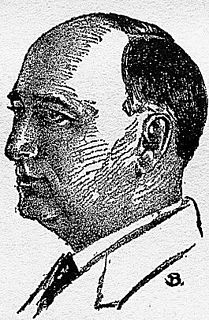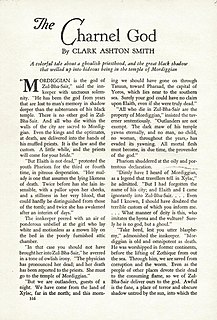
Clark Ashton Smith was an American writer and artist. He achieved early local recognition, largely through the enthusiasm of George Sterling, for traditional verse in the vein of Swinburne. As a poet, Smith is grouped with the West Coast Romantics alongside Joaquin Miller, Sterling, and Nora May French and remembered as "The Last of the Great Romantics" and "The Bard of Auburn". Smith's work was praised by his contemporaries. H. P. Lovecraft stated that "in sheer daemonic strangeness and fertility of conception, Clark Ashton Smith is perhaps unexcelled", and Ray Bradbury said that Smith "filled my mind with incredible worlds, impossibly beautiful cities, and still more fantastic creatures".

Algernon Henry Blackwood, CBE was an English broadcasting narrator, journalist, novelist and short story writer, and among the most prolific ghost story writers in the history of the genre. The literary critic S. T. Joshi stated, "His work is more consistently meritorious than any weird writer's except Dunsany's." and that his short story collection Incredible Adventures (1914) "may be the premier weird collection of this or any other century".

Robert William Chambers was an American artist and fiction writer, best known for his book of short stories titled The King in Yellow, published in 1895.

Weird Tales is an American fantasy and horror fiction pulp magazine founded by J. C. Henneberger and J. M. Lansinger in late 1922. The first issue, dated March 1923, appeared on newsstands February 18. The first editor, Edwin Baird, printed early work by H. P. Lovecraft, Seabury Quinn, and Clark Ashton Smith, all of whom went on to be popular writers, but within a year, the magazine was in financial trouble. Henneberger sold his interest in the publisher, Rural Publishing Corporation, to Lansinger, and refinanced Weird Tales, with Farnsworth Wright as the new editor. The first issue under Wright's control was dated November 1924. The magazine was more successful under Wright, and despite occasional financial setbacks, it prospered over the next 15 years. Under Wright's control, the magazine lived up to its subtitle, "The Unique Magazine", and published a wide range of unusual fiction.

George Oliver Onions, who published under the name Oliver Onions, was an English writer of short stories and over 40 novels. He wrote in various genres, but is perhaps best remembered for his ghost stories, notably the collection Widdershins and the widely anthologized novella "The Beckoning Fair One". He was married to the novelist Berta Ruck.

"Red Nails" is the last of the stories featuring Conan the Cimmerian written by American author Robert E. Howard. A novella, it was originally serialized in Weird Tales magazine from July to October 1936. It's set in the pseudo-historical Hyborian Age and concerns Conan encountering a lost city in which the degenerate inhabitants are proactively resigned to their own destruction. Due to its dark themes of decay and death, the story is considered a classic of Conan lore while also cited by Howard scholars as one of his best tales.

David Henry Keller was an American writer who worked for pulp magazines in the mid-twentieth century, in the science fiction, fantasy and horror genres. He was the first psychiatrist to write for the genre, and was most often published as David H. Keller, MD, but also known by the pseudonyms Monk Smith, Matthew Smith, Amy Worth, Henry Cecil, Cecilia Henry, and Jacobus Hubelaire.
Farnsworth Wright was the editor of the pulp magazine Weird Tales during the magazine's heyday, editing 179 issues from November 1924–March 1940. Jack Williamson called Wright "the first great fantasy editor".

"The Testament of Athammaus" is a short story by American writer Clark Ashton Smith, part of his Hyperborean cycle. It was published in the October 1932 issue of Weird Tales.

Witch House is a fantasy novel by American writer Evangeline Walton. It was published in 1945 by Arkham House in an edition of 3,000 copies. It was the first full-length novel to be published by Arkham House and was listed as the initial book in the Library of Arkham House Novels of Fantasy and Terror. An expanded version, with a newly written 20,000-word prologue, was published in England in 1950. In 2013, Centipede Press issued the first American edition of this revised version, also including previously unpublished writings by Walton and several of her short stories.

Arthur J. Burks was an American pulp fiction writer and Marine colonel.
"The Ninth Skeleton" is a short story by American writer Clark Ashton Smith. It was first published in the September 1928 issue of Weird Tales. It was his first story for Weird Tales.

"The Dark Eidolon" is a sword and sorcery short story by American writer Clark Ashton Smith, forming part of his Zothique cycle of stories. It was first published in Weird Tales in 1935 and has been variously republished, notably in the anthology The Spell of Seven, edited by L. Sprague de Camp.
The Dark Chamber is a 1927 horror novel by American writer Leonard Cline.

Strange Tales was an American pulp magazine first published from 1931 to 1933 by Clayton Publications. It specialized in fantasy and weird fiction, and was a significant competitor to Weird Tales, the leading magazine in the field. Its published stories include "Wolves of Darkness" by Jack Williamson, as well as work by Robert E. Howard and Clark Ashton Smith. The magazine ceased publication when Clayton entered bankruptcy. It was temporarily revived by Wildside Press, which published three issues edited by Robert M. Price from 2003 to 2007.

"Necromancy in Naat" is a short story by American author Clark Ashton Smith as part of his Zothique cycle, and first published in the July 1936 issue of Weird Tales.

"The Death of Ilalotha" is a short story by American author Clark Ashton Smith as part of his Zothique cycle, and first published in the September 1937 issue of Weird Tales.

"The Charnel God" is a short story by American author Clark Ashton Smith as part of his Zothique cycle, and first published in the March 1934 issue of Weird Tales.

"The Last Hieroglyph " is a short story by American author Clark Ashton Smith as part of his Zothique cycle, and first published in the April 1935 issue of Weird Tales.

"The Voyage of King Euvoran" is a short story by American author Clark Ashton Smith as part of his Zothique cycle. It was first published as "The Voyage of King Euvoran" in the 1933 book The Double Shadow and Other Fantasies. It was republished as "Quest of the Gazolba" in the September 1947 issue of Weird Tales where it was the cover story with art by Boris Dolgov.

















